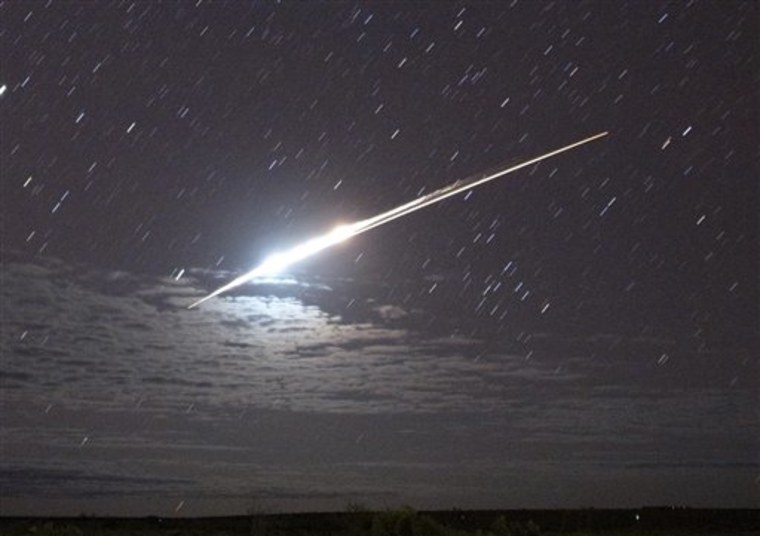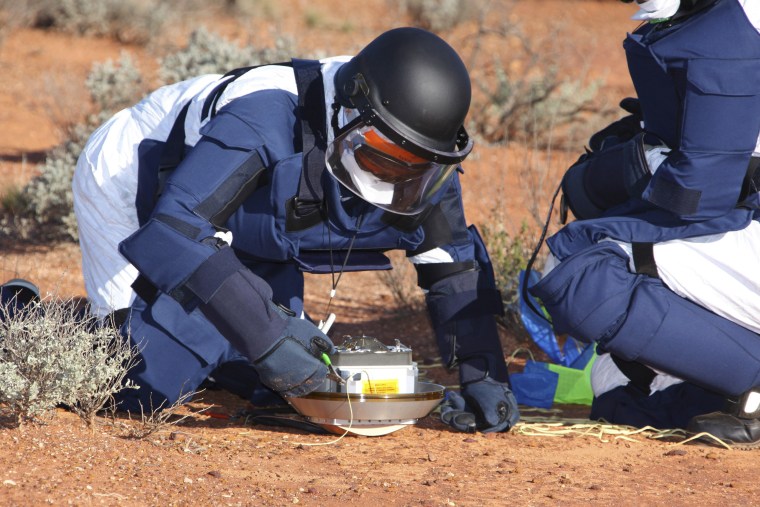A team of scientists flew to the Australian Outback on Monday and recovered a Japanese space capsule that they hope contains asteroid samples providing clues into the evolution of the solar system.
The Hayabusa explorer returned to Earth overnight after a seven-year, 4-billion mile (6-billion kilometer) journey, burning apart on re-entry in a spectacular fireball just after jettisoning the capsule. It was the first time a spacecraft successfully landed on an asteroid and returned to Earth.
Seiichi Sakamoto of the Japan Aerospace Exploration Agency, which launched the explorer in 2003, said they were "delighted" to recover the capsule, particularly after a number of technical problems delayed Hayabusa's arrival for three years.
"It was an extremely difficult technological challenge, and we did everything to overcome the troubles one by one," he said. "This is an achievement we could make simply because we never gave up hope."
On Monday, two helicopters took scientists to the capsule's landing site in the Woomera Prohibited Area, a remote military zone 300 miles (485 kilometers) northwest of the South Australian state capital of Adelaide.
The capsule was airlifted late Monday afternoon to the town of Woomera, where it would be prepared over several days for air freighting to Japan, NASA scientist Scott Sandford said by telephone from the scientists' base in Woomera.
Sandford said he had not seen the capsule but that photographs indicated it had made a soft desert landing.
The capsule will return to Japan before scientists discover whether it carries any asteroid dust in its sample canister.
"It'll be some time before we know if we've got sample, and if so, how much — I don't think we can assume anything," Sandford said.

Sandford said it was a relief to watch the re-entry and see the capsule successfully detach and parachute to Earth.
"During a mission critical event like a re-entry, there's a whole series of things you've got to get right to make it work, and they all seemed to have come off without a hitch," said Sandford. "It's a great testament to the design and operation of the spacecraft."
Hayabusa reached an asteroid called Itokawa in 2005. After taking photo images from all angles of the 1,640-foot (500-meter) -long asteroid, Hayabusa landed on it twice in late 2005.
The craft was designed to shoot a bullet into the surface of the asteroid that would crush and propel material through a long tube into a sample collection container. There is no certainty the bullet actually fired, scientists say, but they believe the impact of the tube's landing would have forced some material upward and into the collection chamber.
Slideshow 12 photos
Month in Space: January 2014
"We have perhaps a 50 percent chance" of retrieving samples, Sakamoto said.
The Japanese space agency said the aim of the $200 million project was to understand the origin and evolution of the solar system, as well as paving the way for future sample return missions.
Sakamoto said any samples from an asteroid, considered the building blocks of planets, could also shed light on the origins of the Earth.
Scientists hope to study how and when the asteroid was formed, its physical properties, what other bodies it may have been in contact with, and how solar wind and radiation have affected it.
Hayabusa was originally due to return to Earth in 2007 but a series of technical glitches — including a deterioration of its ion engines, broken control wheels, and the malfunctioning of electricity-storing batteries — forced it to miss its window to maneuver into the Earth's orbit until this year.
If Hayabusa is indeed carrying asteroid samples, it would be only the fourth space sample return in history — including moon matter collected by the Apollo missions, comet material by Stardust, and solar matter from the Genesis mission.
Preliminary analysis of the samples will be carried out by the team of Japanese, American and Australian scientists in Japan. After one year, scientists around the world can apply for access to the asteroid material for research.

